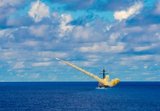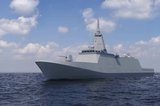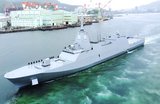Chilean Navy and ASMAR launch new icebreaker
Almirante Viel vessel in the Talcahuano Naval Base. (Photo: Chilean MoD)
The Chilean Navy is progressing with its plans to operate a new icebreaker in 2024. During a ceremony in the Talcahuano Naval Base (Concepción region) on 22 December, the service launched the Almirante Viel vessel.
Designed by the Canadian company VARD Marine and built by the national shipyard ASMAR, the icebreaker will cover a paramount role by supporting Chile’s bases in Antarctic.
Capable of operating at -30°C, the ship can break up to 1 m thick layer of ice and will be equipped with microbiological, macrobiological and chemical laboratories.
Related Articles
FAMAE sets sights on 122mm MLRS
South American shipyards maintain their tempo
Chile to develop flight instruction system
With a length of 111 m, a beam of 21 m, a draught of 7.2 meters and a displacement of 10,500 tonnes, Almirante Viel has been built under the Antártica-I programme.
A press release issued by the Chilean MoD stated that the vessel is ‘the most complex project’ conducted to date by ASMAR.
Shephard Defence Insight notes that the new vessel will replace the icebreaker also named Almirante Viel, which was decommissioned in 2019.
Related Programmes in Defence Insight
Antártica-I Icebreaker [Chile]
Related Equipment in Defence Insight
More from Naval Warfare
-
![Future of the Canadian Patrol Submarine Project is still unclear]()
Future of the Canadian Patrol Submarine Project is still unclear
The Canadian government remains tight-lipped on the timeline and funding required for the next steps of its Canadian Submarine Patrol Project, which should offer improved capabilities for the country’s navy.
-
![Thales’ new Sonar 76Nano could equip UK Royal Navy on anti-submarine warfare missions]()
Thales’ new Sonar 76Nano could equip UK Royal Navy on anti-submarine warfare missions
The new sonar is designed to equip uncrewed underwater vessels, with the potential to be used by the Royal Navy for its Atlantic Bastion and Atlantic Net missions.
-
![Hanwha wins Australian government approval to increase its stake in Austal]()
Hanwha wins Australian government approval to increase its stake in Austal
The contract would mean the two shipbuilders can collaborate strategically and enhance shipbuilding capabilities in Western Australia.






















